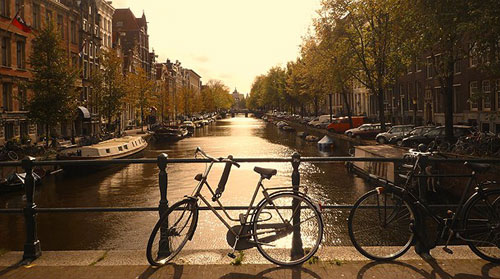The traveller who arrives in Amsterdam for the first time cannot help be surprised by a series of characteristics of the city that tell its open, respectful and civilized spirit, such as liberal policies on cannabis consumption or prostitution, as long as they´re carried out in specific places used only for such purposes. Another surprising thing is the large amount of bicycles that exist -they say that around 45% of the citizens of Amsterdam use this transport every day-, which has meant that the city now has the unofficial nickname of the ´City of Bicycles´.

Among the reasons for that there are some that are naturally linked to the configuration and shape of the city. Amsterdam, like most of Holland, is land gained on the sea after much human intervention throughout the centuries, which ends up in a profusion of zig-zagging narrow canals, and travelling around them by car is not very practical. For similar reasons, another factor to take into account is the sensible lack of parking areas in the urban space. The aforementioned circumstances gain even more importance in the lovely historical city centre, built mostly in the 17th century, whose narrow and tortuous streets don´t really tend to be car friendly.
Perhaps in connection with the practical spirit of its citizens, these reasons have contributed to the development of an ecologic conscience in Amsterdam, which favours the use of bicycles even more, a reason why they say that Amsterdammers are born on one of them, which would explain their masterful handling of the bicycles, something which would be a lot harder in any other European city.
From what we said before it would be easy to deduce that the cyclist comes across strange objects in the Dutch capital, designed especially to fit its needs. Therefore, there are many bicycle lanes (up to 250 miles of them to connect almost all the spots in the city amongst themselves) and the facilities for its efficient and civilized use, without coming into conflict with the trams, buses or cars.
All of this results in a considerably different urban experience to any other anywhere else in Europe since moving around the city by bicycle, aside from offering an ecological alternative to pollution, contaminating fumes and energy use from fossile materials, also helps us to live a more healthy lifestyle at a much more calm and relaxed rhythm, which invites to thought, contemplation and aesthetic appreciation. Also, it gives us back some sort of haptic feeling from architecture and urbanism, reinstating the touch of a perceptive experience of space and therefore, also, of the world that surrounds us.

 English
English Español
Español